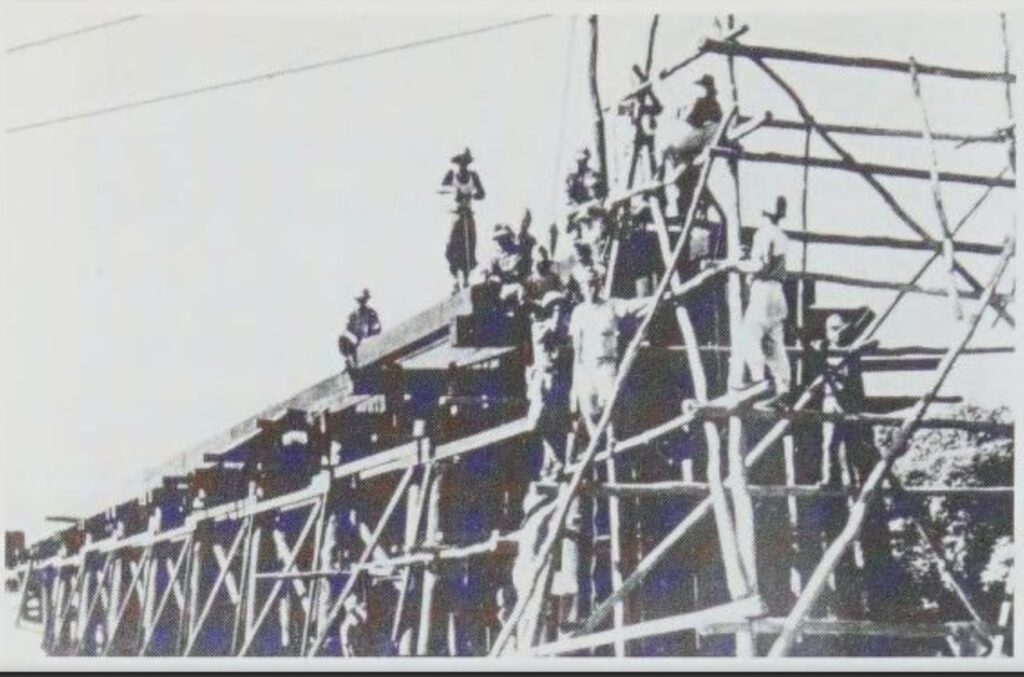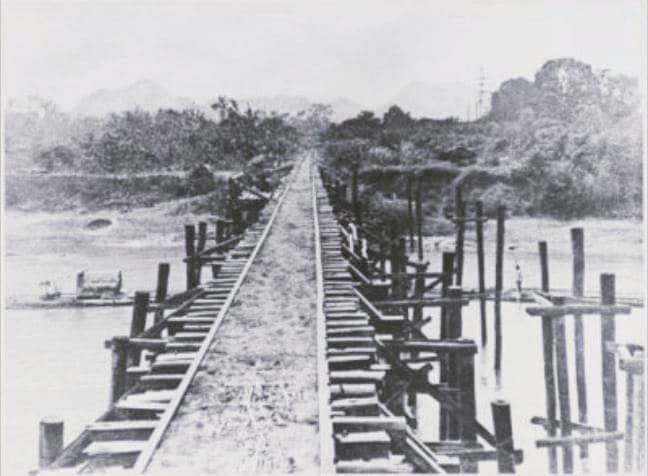Who were the men who built the TBR and where did they come from?
Because the two sectors were so different, it is easier if we discuss them separately.
THAI SECTOR
The POWs who worked the Thai Sector were primarily British who were captured in Singapore. As is true of all who worked this Sector, the first group arrived by train in Jun 42. They established a camp at the existing rail yard at NongPlaDuk. There they stockpiled supplies and expanded the capabilities of the facility.
As soon as hired Thai workers completed the Railway to Kanchanaburi, the Engineer HQ and support staff moved there from BanPong. Soon thereafter, LtCol Toosey’s men moved from NongPlaDuk to begin building the wooden bridge at Thamakam. They would be joined in Jan 43 by Dutch POWs who came from Java via train from Singapore.


Meanwhile, a continuous parade of trains each carrying an average of about 600 POWs or romusha was arriving at the Ban Pong transit camp. If transportation was available, they were ferried to KAN otherwise they walked. Upon arrival at KAN they boarded barges and were hauled to their work camps along the Kwae Noi River. The first true TBR work camp was ChungKai located on the bank of the river about 3 kms from the bridges. Work progressed swiftly on the next 50 Kms up to WangPo traversing relatively flat unobstructed terrain. These camps were populated by British POWs.
A huge limestone outcropping at WangPo was a milestone in a number of ways. First it required the construction of a trestle that still clings precariously to the rock face some 12m about the river. Secondly, the rail trace begins to move inland making access from the river more difficult. Lastly, the mountain prohibited passage by newly arriving work parties. In order to reach the camps beyond WangPo, the workers had to proceed past KAN in the direction of LatYa. They crossed a bridge over the MaeKlong (later the Kwae Yai) at Tadan and then proceeded south towards the river.
The next major obstacle was what would become known as Hellfire Pass. This is the first place where we know that Australian POWs (D Force) worked alongside romusha. The next section is known as Hintok. It was a transition area where the rails had to be raised into the Thai Highlands via 2 switchback trestles. Here more AUS and romusha workers were joined by a small number of US POWs.
The last 150 Kms in Thailand were built mainly by F Force (3300 British & 3600 AUS) as well as tens of thousands of romusha. This was in the rough terrain of the Highlands. At Three Pagodas Pass, the trace reached its highest elevation of 300m. Distance, accessibility, monsoon rains and then cholera rendered conditions in this portion of the TBR a living hell. Deaths tolls approached 50% in some groups.
One of the unexplained aspects of the overall TBR plan is that the F Force workers were sent to the area beyond Konkoita (KM 263) into the area that was the responsibility of the Fifth Railway Regiment who oversaw the Burma Sector. Technically, F Force was not assigned to either the Fifth or the Ninth Regiment, but remained under the Singapore Command. This further exacerbated some of their hardships.
A total of over 45,000 POWs worked in the Thai Sector; over half of them (29,000) were British. There were slightly more Dutch (9000) than Australian (7000) and only a few dozen Americans. The generally accepted figure of 250,000 romusha worked alongside the POWs, most of them on the Highlands area.
BURMA SECTOR
The Burma Sector overseen by the Fifth Railway Regiment was shorter than the Thai. It ran 110 km from Thanbyuzayat to the Thai border at Three Pagodas Pass then another 40 km to Konkoita. Like the Thai side, the first 50-60 kms were over relatively flat unobstructed terrain. The rise into the Highlands was then more gradual precluding the need for switchbacks. The mountains that formed the border area ran north-south across the path of the TBR so many bridges were required to cross the streams and rivers in the valleys between these mountains.
There were only about 12,000 POWs in Burma; almost evenly divided between AUS and Dutch. There were only 500 British and 660 Americans. The bulk of the work force consisted of locally ‘procured’ native Burmese and Hilltribesmen; over 100,000 in all. Even without the access provided by the parallel river on the Thai side, the conditions in the Burmese camps were somewhat better than in Thailand; not good but better.
Except for the small British group who came to Burma via Sumatra after escaping from Singapore, all the Burma Sector POWs were captured on Java. They arrived in Burma by ships sailing from Singapore where they had varying lengths of lay-overs after leaving the DEI[1]. A Force, the first 3000 AUS POWs, were actually sent to Burma in May 42 to build an airstrip and only later joined the TBR workforce. The first 200 US POWs arrived in OCT 42 as part of Williams Force. The larger group of 450 under the command of LTC Tharp did not arrive until JAN 43 having stayed in Singapore for nearly 3 months.
A lack of iron rails delayed the completion of the Burmese Sector. While POWs and Burmese romusha worked on the rail bed berms and bridges, IJA engineers were tearing up rails in Malaya to be shipped to Burma.
As noted above, it is somewhat unclear why the Burmese Sector work groups did not continue on into Thailand. Thai-based F Force and romusha completed the 40 km stretch from the border to Konkoita where the joining ceremony was held. After F Force was returned to Singapore, Burmese-side POW groups occupied the camps in Thailand that had been ravaged by cholera.
CONSOLIDATION
Following the completion of the TBR in OCT 43, all the workers were consolidated to camps near KAN City. This took a considerable amount of time, with the last US POWs arriving there in May 44. Likely the last to arrive were the romusha who worked the Kra Ithmus and Megui Road projects.
The surviving members of H and F Force were returned to Singapore since they had never been formally transferred to the Ninth Railway Regiment’s control. Thousands of the TBR survivors had to be hospitalized in KAN or Nakorn Pathom. Small groups were transferred to other projects such as airfields in Ubon and Petchburi. Hundreds of TBR survivors were sent on to either Japan or French-Indo China. Those not so transferred actually spent more time at the KAN ‘rest camps’ than they did working the TBR.
Within a few weeks of the Japanese surrender, the majority of the POWs were gathered from the various camps and brought to Bangkok for evacuation. The exception were the Dutch who remained in the KAN area well into 1946 due to political unrest as the natives rebelled against the colonial Dutch rule in what would become Indonesia. Of course, no one assisted the romusha in any way!
[1] It is noteworthy that the Australian D Force (2000 men) was sent to Thailand having been captured on Java. Most of the 8000 AUS POWs in Thailand were captured at Singapore.
